Deck 2: The Nature of Sets
Question
Question
Question
Question
Question
Question
Question
Question
Question
Question
Question
Question
Question
Question
Question
Question
Question
Question
Question
Question
Question
Question
Question
Question
Question
Question
Question
Question
Question
Question
Question
Question
Question
Question
Question
Question
Question
Question
Question
Question
Question
Question
Question
Question
Question
Question
Question
Question
Question
Question
Question
Question
Question
Question
Question
Question
Question
Question
Question
Question
Question
Question
Question
Question

Unlock Deck
Sign up to unlock the cards in this deck!
Unlock Deck
Unlock Deck
1/64
Play
Full screen (f)
Deck 2: The Nature of Sets
1
Show that the set is infinite by placing it into a one-to-one correspondence with a proper subset of itself.


We can show that the set  can be placed into a one-to-one correspondence with a proper subset of itself
can be placed into a one-to-one correspondence with a proper subset of itself  :
:

Since is a proper subset of A, we see that the set
is a proper subset of A, we see that the set  is infinite.
is infinite.
 can be placed into a one-to-one correspondence with a proper subset of itself
can be placed into a one-to-one correspondence with a proper subset of itself  :
:

Since
 is a proper subset of A, we see that the set
is a proper subset of A, we see that the set  is infinite.
is infinite. 2
Determine whether the statement is true or false.
If two sets are uncountable, then they are equivalent.
If two sets are uncountable, then they are equivalent.
False
3
Use set notation to identify the shaded region. 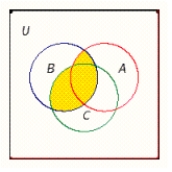
A)
B)
C)
D)
E)

A)

B)

C)

D)

E)


4
Determine whether the statement is true or false.
All infinite sets are uncountable.
All infinite sets are uncountable.

Unlock Deck
Unlock for access to all 64 flashcards in this deck.
Unlock Deck
k this deck
5
Decide whether the set is countably infinite.
Set of whole numbers.
A) no
B) yes
Set of whole numbers.
A) no
B) yes

Unlock Deck
Unlock for access to all 64 flashcards in this deck.
Unlock Deck
k this deck
6
Show that the set is infinite by placing it into a one-to-one correspondence with a proper subset of itself. 
A) 
B) 
C)
D) 
E) 

A)

B)

C)

D)

E)


Unlock Deck
Unlock for access to all 64 flashcards in this deck.
Unlock Deck
k this deck
7
Determine whether the statement is true or false.
All countable sets are infinite.
All countable sets are infinite.

Unlock Deck
Unlock for access to all 64 flashcards in this deck.
Unlock Deck
k this deck
8
Give the cardinality of the set 
A) 1,087
B) 1,089
C) 1,088
D) 1,084
E) 1,093

A) 1,087
B) 1,089
C) 1,088
D) 1,084
E) 1,093

Unlock Deck
Unlock for access to all 64 flashcards in this deck.
Unlock Deck
k this deck
9
Show that the set has cardinality  .
.
Set of multiples of 5.
A) 
B) 
C)
D)
E) 
 .
. Set of multiples of 5.
A)

B)

C)

D)

E)


Unlock Deck
Unlock for access to all 64 flashcards in this deck.
Unlock Deck
k this deck
10
Show that the set has cardinality  .
.
{- 1, - 2, - 3, ...}
 .
.
{- 1, - 2, - 3, ...}

Unlock Deck
Unlock for access to all 64 flashcards in this deck.
Unlock Deck
k this deck
11
If  and
and  , what is
, what is  ?
?
 and
and  , what is
, what is  ?
?
Unlock Deck
Unlock for access to all 64 flashcards in this deck.
Unlock Deck
k this deck
12
If  and
and  , what is
, what is  ?
?
A) 2,600
B) 800
C) 80
D) 100
E) 250
 and
and  , what is
, what is  ?
? A) 2,600
B) 800
C) 80
D) 100
E) 250

Unlock Deck
Unlock for access to all 64 flashcards in this deck.
Unlock Deck
k this deck
13
Decide whether the set is countably infinite. Answer yes or no.
Set of even numbers.
Set of even numbers.

Unlock Deck
Unlock for access to all 64 flashcards in this deck.
Unlock Deck
k this deck
14
Consider the sets X and Y. Write the statement in symbols.
The complement of the intersection of X and Y.
A)
B)
C)
D)
E)
The complement of the intersection of X and Y.
A)

B)

C)

D)

E)


Unlock Deck
Unlock for access to all 64 flashcards in this deck.
Unlock Deck
k this deck
15
Show that the set has cardinality  .
. 
A)
B)
C)
D)
E)
 .
. 
A)

B)

C)

D)

E)


Unlock Deck
Unlock for access to all 64 flashcards in this deck.
Unlock Deck
k this deck
16
Show that the set has cardinality  .
.
Set of even counting numbers.
 .
.
Set of even counting numbers.

Unlock Deck
Unlock for access to all 64 flashcards in this deck.
Unlock Deck
k this deck
17
Give the cardinality of the set



Unlock Deck
Unlock for access to all 64 flashcards in this deck.
Unlock Deck
k this deck
18
Determine whether the statement is true or false.
If two sets are equivalent, then they are countable.
If two sets are equivalent, then they are countable.

Unlock Deck
Unlock for access to all 64 flashcards in this deck.
Unlock Deck
k this deck
19
Let U = {1, 2, 3, 4, 5, 6, 7}, A = {1, 2, 3, 6}, B = {1, 2, 6, 7}, C = {3, 6, 7}. List all the members of the set. 
A) {2, 4, 6}
B) {1, 2, 6, 7}
C) {1, 2, 3, 6}
D) {4, 5, 6, 7}
E) {6}

A) {2, 4, 6}
B) {1, 2, 6, 7}
C) {1, 2, 3, 6}
D) {4, 5, 6, 7}
E) {6}

Unlock Deck
Unlock for access to all 64 flashcards in this deck.
Unlock Deck
k this deck
20
Using the Venn diagram in the figure, specify which regions are described by each expression:  ,
, 
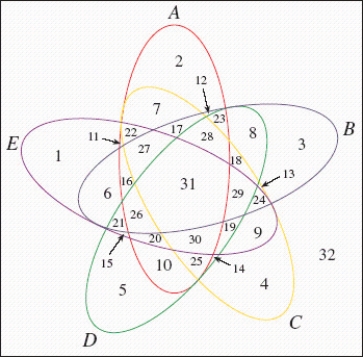
A) Region 31, Region 5
B) Region 24, Region 2
C) Region 32, Region 3
D) Region 28, Region 4
E) Region 32, Region 31
 ,
, 

A) Region 31, Region 5
B) Region 24, Region 2
C) Region 32, Region 3
D) Region 28, Region 4
E) Region 32, Region 31

Unlock Deck
Unlock for access to all 64 flashcards in this deck.
Unlock Deck
k this deck
21
Perform the given set operation.
Let U = {1, 2, 3, 4, 5, 6, 7, 8, 9}.

A) {1, 3, 5 ,7}
B) {2, 4, 6}
C) {1, 2, 3, 4, 5, 6, 7, 8}
D) {2, 4, 6, 8, 10}
E) {1, 3, 5, 7, 9}
Let U = {1, 2, 3, 4, 5, 6, 7, 8, 9}.

A) {1, 3, 5 ,7}
B) {2, 4, 6}
C) {1, 2, 3, 4, 5, 6, 7, 8}
D) {2, 4, 6, 8, 10}
E) {1, 3, 5, 7, 9}

Unlock Deck
Unlock for access to all 64 flashcards in this deck.
Unlock Deck
k this deck
22
Perform the given operations. Let U = {1, 2, 3, 4, 5, 6, 7, 8, 9, 10} (U represents the universal set). 
A)
B)
C)
D)
E)

A)

B)

C)

D)

E)


Unlock Deck
Unlock for access to all 64 flashcards in this deck.
Unlock Deck
k this deck
23
Let U = {1, 2, 3, 4, 5, 6, 7}, A = {1, 2, 3, 5}, B = {1, 2, 5, 6}, C = {3, 5, 7}. List all the members of the set below.

{ __________ }

{ __________ }

Unlock Deck
Unlock for access to all 64 flashcards in this deck.
Unlock Deck
k this deck
24
Draw a Venn diagram for the relationship. 
A) 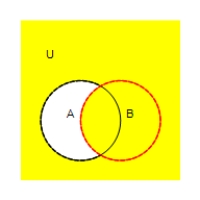
B) 
C) 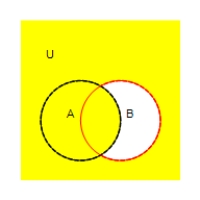
D) 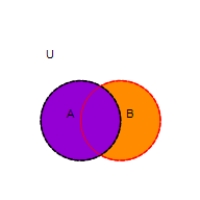

A)

B)

C)

D)


Unlock Deck
Unlock for access to all 64 flashcards in this deck.
Unlock Deck
k this deck
25
Use set notation to identify the shaded region.

Please enter parentheses to indicate the order of operations.

Please enter parentheses to indicate the order of operations.

Unlock Deck
Unlock for access to all 64 flashcards in this deck.
Unlock Deck
k this deck
26
Draw a Venn diagram showing birds, bees, and living creatures.
A)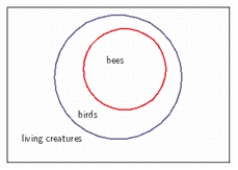
B)
C)
D)
E)
A)

B)

C)

D)

E)


Unlock Deck
Unlock for access to all 64 flashcards in this deck.
Unlock Deck
k this deck
27
Perform the given set operation.
Let U = {1, 2, 3, 4, 5, 6, 7, 8, 9, 10}.

A) {1, 2, 3, 4, 5, 6, 7, 8, 9, 10}
B) {1, 3, 5, 7, 9}
C) {2, 4, 6, 8, 10}
D) {1, 2, 3, 4, 5, 6, 7}
E)
Let U = {1, 2, 3, 4, 5, 6, 7, 8, 9, 10}.

A) {1, 2, 3, 4, 5, 6, 7, 8, 9, 10}
B) {1, 3, 5, 7, 9}
C) {2, 4, 6, 8, 10}
D) {1, 2, 3, 4, 5, 6, 7}
E)


Unlock Deck
Unlock for access to all 64 flashcards in this deck.
Unlock Deck
k this deck
28
A poll was taken of 214 students at a commuter campus to find out how they got to campus. How many used none of the mentioned means of transportation? The results of the poll were:
34 said they drove alone.
31 rode in a carpool.
35 rode public transportation.
8 used both carpools and public transportation.
7 used both a carpool and sometimes their own cars.
9 used buses as well as their own cars.
8 used all three methods.
__________ students
34 said they drove alone.
31 rode in a carpool.
35 rode public transportation.
8 used both carpools and public transportation.
7 used both a carpool and sometimes their own cars.
9 used buses as well as their own cars.
8 used all three methods.
__________ students

Unlock Deck
Unlock for access to all 64 flashcards in this deck.
Unlock Deck
k this deck
29
Draw Venn diagrams for the relationship 
A) 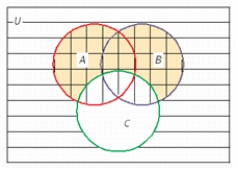
B) 
C) 
D) 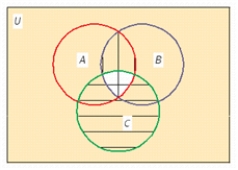
E) 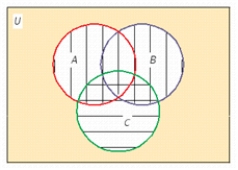

A)

B)

C)

D)

E)


Unlock Deck
Unlock for access to all 64 flashcards in this deck.
Unlock Deck
k this deck
30
Let U = {1, 2, 3, 4, 5, 6, 7}, A = {1, 2, 3, 4} and C = {2, 5, 6}. List all the members of the following set. 
A) {1, 2, 3, 4, 5, 6}
B) {1, 3, 4, 7}
C) {1, 2, 3, 4}
D) {2, 5, 6}
E)

A) {1, 2, 3, 4, 5, 6}
B) {1, 3, 4, 7}
C) {1, 2, 3, 4}
D) {2, 5, 6}
E)


Unlock Deck
Unlock for access to all 64 flashcards in this deck.
Unlock Deck
k this deck
31
In a survey of a TriDelta chapter with 50 members, 16 were taking mathematics, 34 were taking English, and 5 were taking both. How many were not taking either of these subjects?
__________ members
__________ members

Unlock Deck
Unlock for access to all 64 flashcards in this deck.
Unlock Deck
k this deck
32
In a survey of a TriDelta chapter with 46 members, 11 were taking mathematics, 36 were taking English, and 10 were taking both. How many were not taking either of these subjects?
A) 11
B) 6
C) 36
D) 9
E) 10
A) 11
B) 6
C) 36
D) 9
E) 10

Unlock Deck
Unlock for access to all 64 flashcards in this deck.
Unlock Deck
k this deck
33
Let U = {1, 2, 3, 4, 5, 6, 7}, A = {1, 2, 3, 5} and C = {1, 4, 7}. List all the members of the following set. 
A)
B)
C)
D)
E)

A)

B)

C)

D)

E)


Unlock Deck
Unlock for access to all 64 flashcards in this deck.
Unlock Deck
k this deck
34
Let U = {1, 2, 3, 4, 5, 6, 7}, A = {1, 2, 3, 5} and C = {3, 4, 6}. List all the members of the following set. 
A)
B)
C)
D)
E)

A)

B)

C)

D)

E)


Unlock Deck
Unlock for access to all 64 flashcards in this deck.
Unlock Deck
k this deck
35
Montgomery College has a 47-piece band and a 43-piece orchestra. If 18 people are members of both the band and the orchestra, can the band and orchestra travel in two 37-passenger buses?
A) yes
B) no
A) yes
B) no

Unlock Deck
Unlock for access to all 64 flashcards in this deck.
Unlock Deck
k this deck
36
Perform the given operation. Let U = {1, 2, 3, 4, 5, 6, 7, 8, 9, 10} (U represents the universal set). 
A)
B)
C)
D)
E)

A)

B)

C)

D)

E)


Unlock Deck
Unlock for access to all 64 flashcards in this deck.
Unlock Deck
k this deck
37
Using the Venn diagram in the figure, specify which regions are described by each expression:
 ,
, 
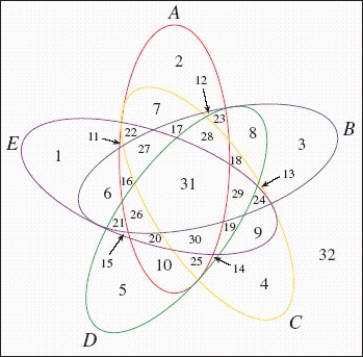
 describes the region number __________.
describes the region number __________.
 describes the region number __________.
describes the region number __________.
 ,
, 

 describes the region number __________.
describes the region number __________.
 describes the region number __________.
describes the region number __________.
Unlock Deck
Unlock for access to all 64 flashcards in this deck.
Unlock Deck
k this deck
38
Draw Venn diagrams for the relationship 
A) 
B) 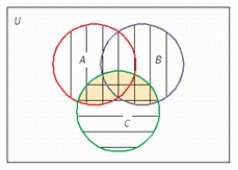
C) 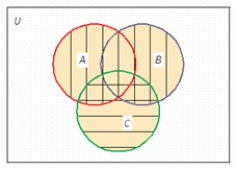
D) 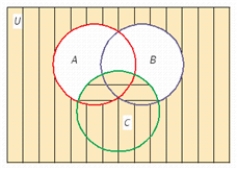
E) 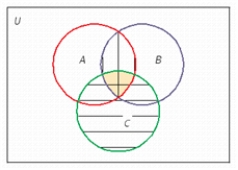

A)

B)

C)

D)

E)


Unlock Deck
Unlock for access to all 64 flashcards in this deck.
Unlock Deck
k this deck
39
Consider the sets X and Y. Write the statement in symbols.
The complement of the union of X and Y.
Enter to represent
to represent  .
.
The complement of the union of X and Y.
Enter
 to represent
to represent  .
.
Unlock Deck
Unlock for access to all 64 flashcards in this deck.
Unlock Deck
k this deck
40
The fire department wants to send booklets on fire hazards to all teachers and homeowners in town. How many booklets does it need, using these statistics? 35,000 homeowners
6,000 teachers
3,000 teachers who own their own homes
A) 9,000
B) 32,000
C) 38,000
D) 26,000
E) 44,000
6,000 teachers
3,000 teachers who own their own homes
A) 9,000
B) 32,000
C) 38,000
D) 26,000
E) 44,000

Unlock Deck
Unlock for access to all 64 flashcards in this deck.
Unlock Deck
k this deck
41
Consider the set
A = {distinct letters in the word pipe}
What is the cardinality of it?
A) 9
B) 3
C) 10
D) 2
E) 5
A = {distinct letters in the word pipe}
What is the cardinality of it?
A) 9
B) 3
C) 10
D) 2
E) 5

Unlock Deck
Unlock for access to all 64 flashcards in this deck.
Unlock Deck
k this deck
42
Perform the given operation. Let U = {1, 2, 3, 4, 5, 6, 7, 8, 9, 10} (U represents the universal set).

Enter your answer using set notation.

Enter your answer using set notation.

Unlock Deck
Unlock for access to all 64 flashcards in this deck.
Unlock Deck
k this deck
43
List the set in roster form. 
A) 2, 3, 4, 5, 6, 7, 8, 9, 10
B) 0, 1, 2, 3, 4, 5, 6, 7, 8, 9, 10, 11, 12, 13, 14
C) 2, 4, 6, 8, 10, 12, 14
D) 1, 3, 5, 7, 9, 11, 13
E) 0, 1, 2, 3, 4, 5, 6, 7, 8, 9, 10, 11, 12, 13, 14,15

A) 2, 3, 4, 5, 6, 7, 8, 9, 10
B) 0, 1, 2, 3, 4, 5, 6, 7, 8, 9, 10, 11, 12, 13, 14
C) 2, 4, 6, 8, 10, 12, 14
D) 1, 3, 5, 7, 9, 11, 13
E) 0, 1, 2, 3, 4, 5, 6, 7, 8, 9, 10, 11, 12, 13, 14,15

Unlock Deck
Unlock for access to all 64 flashcards in this deck.
Unlock Deck
k this deck
44
Montgomery College has a 50-piece band and a 36-piece orchestra. If 14 people are members of both the band and the orchestra, can the band and orchestra travel in two 40-passenger buses?
Answer yes or no.
Answer yes or no.

Unlock Deck
Unlock for access to all 64 flashcards in this deck.
Unlock Deck
k this deck
45
Tell whether the set is well defined. If it is not well defined, change it so that it is well defined.
The set of students attending the University of California.
__________ (well defined, not well defined)
a. The set of students attending the University of California.
b. The set of students attending the Massachusetts Institute of Technology.
c. The set of students attending the University of Berkeley.
d. The set of students attending Boston University.
e. None of these because the set is well defined.
The set of students attending the University of California.
__________ (well defined, not well defined)
a. The set of students attending the University of California.
b. The set of students attending the Massachusetts Institute of Technology.
c. The set of students attending the University of Berkeley.
d. The set of students attending Boston University.
e. None of these because the set is well defined.

Unlock Deck
Unlock for access to all 64 flashcards in this deck.
Unlock Deck
k this deck
46
Perform the given operation. Let U = {1, 2, 3, 4, 5, 6, 7, 8, 9, 10} (U represents the universal set).

Enter your answer using set notation.

Enter your answer using set notation.

Unlock Deck
Unlock for access to all 64 flashcards in this deck.
Unlock Deck
k this deck
47
Specify the set by roster.
{Counting numbers containing only 4s.}
Enter the first four terms of the set.
{Counting numbers containing only 4s.}
Enter the first four terms of the set.

Unlock Deck
Unlock for access to all 64 flashcards in this deck.
Unlock Deck
k this deck
48
Consider the set
A = {distinct letters in the word tank}
What is the cardinality of it?
A = {distinct letters in the word tank}
What is the cardinality of it?

Unlock Deck
Unlock for access to all 64 flashcards in this deck.
Unlock Deck
k this deck
49
Let U = {1, 2, 3, 4, 5, 6, 7}, A = {1, 2, 3, 5} and C = {3, 4, 7}. List all the members of the set.

Enter your answer using set notation.

Enter your answer using set notation.

Unlock Deck
Unlock for access to all 64 flashcards in this deck.
Unlock Deck
k this deck
50
Tell whether the set is well defined.
{Good bets on the next race at Hialeah.}
A) well defined
B) not well defined
{Good bets on the next race at Hialeah.}
A) well defined
B) not well defined

Unlock Deck
Unlock for access to all 64 flashcards in this deck.
Unlock Deck
k this deck
51
Decide whether the statement is true or false. 


Unlock Deck
Unlock for access to all 64 flashcards in this deck.
Unlock Deck
k this deck
52
"All sparrows are birds". Rephrase this using set terminology.
A) The set of sparrows is not a subset of the set of birds
B) Some birds are a subset of the set of sparrows, and some are not
C) The set of birds is a subset of the set of sparrows
D) Some sparrows are a subset of the set of birds, and some are not
E) The set of sparrows is a subset of the set of birds
A) The set of sparrows is not a subset of the set of birds
B) Some birds are a subset of the set of sparrows, and some are not
C) The set of birds is a subset of the set of sparrows
D) Some sparrows are a subset of the set of birds, and some are not
E) The set of sparrows is a subset of the set of birds

Unlock Deck
Unlock for access to all 64 flashcards in this deck.
Unlock Deck
k this deck
53
Consider the sets 



Which of the sets are equivalent?
A)
B)
C)
D)
E) 




Which of the sets are equivalent?
A)

B)

C)

D)

E)


Unlock Deck
Unlock for access to all 64 flashcards in this deck.
Unlock Deck
k this deck
54
Perform the given set operation.
Let U = {1, 2, 3, 4, 5, 6, 7, 8}.

Enter your answer in a set notation.
Let U = {1, 2, 3, 4, 5, 6, 7, 8}.

Enter your answer in a set notation.

Unlock Deck
Unlock for access to all 64 flashcards in this deck.
Unlock Deck
k this deck
55
Perform the given set operation.
Let U = {1, 2, 3, 4, 5, 6, 7, 8, 9, 10}.

Let U = {1, 2, 3, 4, 5, 6, 7, 8, 9, 10}.


Unlock Deck
Unlock for access to all 64 flashcards in this deck.
Unlock Deck
k this deck
56
Let U = {1, 2, 3, 4, 5, 6, 7}, A = {1, 2, 3, 5} and C = {1, 4, 7}. List all the members of the set.

Enter your answer using set notation.

Enter your answer using set notation.

Unlock Deck
Unlock for access to all 64 flashcards in this deck.
Unlock Deck
k this deck
57
Write out in words the description of the given set, and then list the set in roster form.

This is a set of whole numbers where the terms are __________ than __________.
Enter the terms of the set.

This is a set of whole numbers where the terms are __________ than __________.
Enter the terms of the set.

Unlock Deck
Unlock for access to all 64 flashcards in this deck.
Unlock Deck
k this deck
58
Let U = {1, 2, 3, 4, 5, 6, 7}, A = {1, 2, 3, 5} and C = {1, 4, 6}. List all the members of the set.

Enter your answer using set notation.

Enter your answer using set notation.

Unlock Deck
Unlock for access to all 64 flashcards in this deck.
Unlock Deck
k this deck
59
Decide whether the statement is true or false.



Unlock Deck
Unlock for access to all 64 flashcards in this deck.
Unlock Deck
k this deck
60
Specify the set by roster.
{Counting numbers containing only 4s.}
A) 41, 42, 43, 44, ...
B) 44, 444, 4444, 44444, ...
C) 4, 444, 44444, 4444444, ...
D) 4, 44, 444, 4444, ...
E) 4, 14, 24, 34, 44, ...
{Counting numbers containing only 4s.}
A) 41, 42, 43, 44, ...
B) 44, 444, 4444, 44444, ...
C) 4, 444, 44444, 4444444, ...
D) 4, 44, 444, 4444, ...
E) 4, 14, 24, 34, 44, ...

Unlock Deck
Unlock for access to all 64 flashcards in this deck.
Unlock Deck
k this deck
61
Decide whether the statement is true or false.



Unlock Deck
Unlock for access to all 64 flashcards in this deck.
Unlock Deck
k this deck
62
"All Boeings are airplanes". Rephrase this using set terminology.

Unlock Deck
Unlock for access to all 64 flashcards in this deck.
Unlock Deck
k this deck
63
Consider the sets




Which of the sets are equivalent?




Which of the sets are equivalent?

Unlock Deck
Unlock for access to all 64 flashcards in this deck.
Unlock Deck
k this deck
64
Decide whether the statement is true or false.



Unlock Deck
Unlock for access to all 64 flashcards in this deck.
Unlock Deck
k this deck



